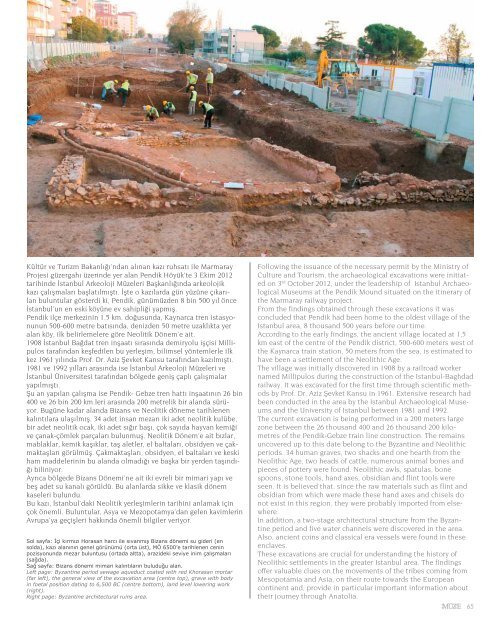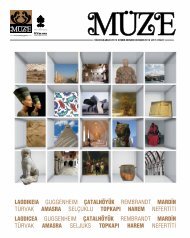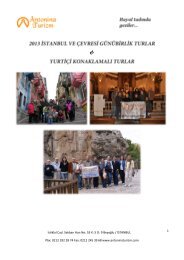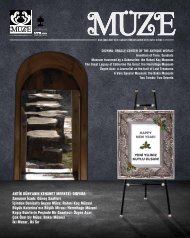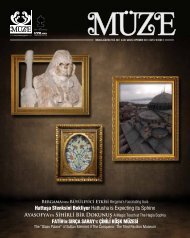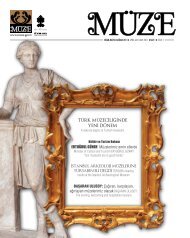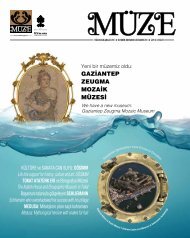DÃNYANIN YENÄ° YEDÄ° HARÄ°KASI SEVEN NEW WONDERS ... - MÃZE
DÃNYANIN YENÄ° YEDÄ° HARÄ°KASI SEVEN NEW WONDERS ... - MÃZE
DÃNYANIN YENÄ° YEDÄ° HARÄ°KASI SEVEN NEW WONDERS ... - MÃZE
Create successful ePaper yourself
Turn your PDF publications into a flip-book with our unique Google optimized e-Paper software.
Kültür ve Turizm Bakanlığı’ndan alınan kazı ruhsatı ile MarmarayProjesi güzergahı üzerinde yer alan Pendik Höyük’te 3 Ekim 2012tarihinde İstanbul Arkeoloji Müzeleri Başkanlığında arkeolojikkazı çalışmaları başlatılmıştı. İşte o kazılarda gün yüzüne çıkarılanbuluntular gösterdi ki, Pendik, günümüzden 8 bin 500 yıl önceİstanbul’un en eski köyüne ev sahipliği yapmış.Pendik ilçe merkezinin 1.5 km. doğusunda, Kaynarca tren istasyonunun500-600 metre batısında, denizden 50 metre uzaklıkta yeralan köy, ilk belirlemelere göre Neolitik Dönem’e ait.1908 İstanbul Bağdat tren inşaatı sırasında demiryolu işçisi Millipulostarafından keşfedilen bu yerleşim, bilimsel yöntemlerle ilkkez 1961 yılında Prof. Dr. Aziz Şevket Kansu tarafından kazılmıştı.1981 ve 1992 yılları arasında ise İstanbul Arkeoloji Müzeleri veİstanbul Üniversitesi tarafından bölgede geniş çaplı çalışmalaryapılmıştı.Şu an yapılan çalışma ise Pendik- Gebze tren hattı inşaatının 26 bin400 ve 26 bin 200 km.leri arasında 200 metrelik bir alanda sürüyor.Bugüne kadar alanda Bizans ve Neolitik döneme tarihlenenkalıntılara ulaşılmış. 34 adet insan mezarı iki adet neolitik kulübe,bir adet neolitik ocak, iki adet sığır başı, çok sayıda hayvan kemiğive çanak-çömlek parçaları bulunmuş. Neolitik Dönem’e ait bızlar,mablaklar, kemik kaşıklar, taş aletler, el baltaları, obsidyen ve çakmaktaşlarıgörülmüş. Çakmaktaşları, obsidyen, el baltaları ve keskiham maddelerinin bu alanda olmadığı ve başka bir yerden taşındığıbiliniyor.Ayrıca bölgede Bizans Dönemi’ne ait iki evreli bir mimari yapı vebeş adet su kanalı görüldü. Bu alanlarda sikke ve klasik dönemkaseleri bulundu.Bu kazı, İstanbul’daki Neolitik yerleşimlerin tarihini anlamak içinçok önemli. Buluntular, Asya ve Mezopotamya’dan gelen kavimlerinAvrupa’ya geçişleri hakkında önemli bilgiler veriyor.Sol sayfa: İçi kırmızı Horasan harcı ile sıvanmış Bizans dönemi su gideri (ensolda), kazı alanının genel görünümü (orta üst), MÖ 6500’e tarihlenen ceninpozisyonunda mezar buluntusu (ortada altta), arazideki seviye inim çalışmaları(sağda).Sağ sayfa: Bizans dönemi mimari kalıntıların buluduğu alan.Left page: Byzantine period sewage aqueduct coated with red Khorasan mortar(far left), the general view of the excavation area (centre top), grave with bodyin foetal position dating to 6,500 BC (centre bottom), land level lowering work(right).Right page: Byzantine architectural ruins area.Following the issuance of the necessary permit by the Ministry ofCulture and Tourism, the archaeological excavations were initiatedon 3 rd October 2012, under the leadership of Istanbul ArchaeologicalMuseums at the Pendik Mound situated on the itinerary ofthe Marmaray railway project.From the findings obtained through these excavations it wasconcluded that Pendik had been home to the oldest village of theIstanbul area, 8 thousand 500 years before our time.According to the early findings, the ancient village located at 1,5km east of the centre of the Pendik district, 500-600 meters west ofthe Kaynarca train station, 50 meters from the sea, is estimated tohave been a settlement of the Neolithic Age.The village was initially discovered in 1908 by a railroad workernamed Millipulos during the construction of the Istanbul-Baghdadrailway. It was excavated for the first time through scientific methodsby Prof. Dr. Aziz Şevket Kansu in 1961. Extensive research hadbeen conducted in the area by the Istanbul Archaeological Museumsand the University of Istanbul between 1981 and 1992.The current excavation is being performed in a 200 meters largezone between the 26 thousand 400 and 26 thousand 200 kilometresof the Pendik-Gebze train line construction. The remainsuncovered up to this date belong to the Byzantine and Neolithicperiods. 34 human graves, two shacks and one hearth from theNeolithic Age, two heads of cattle, numerous animal bones andpieces of pottery were found. Neolithic awls, spatulas, bonespoons, stone tools, hand axes, obsidian and flint tools wereseen. It is believed that, since the raw materials such as flint andobsidian from which were made these hand axes and chisels donot exist in this region, they were probably imported from elsewhere.In addition, a two-stage architectural structure from the Byzantineperiod and five water channels were discovered in the area.Also, ancient coins and classical era vessels were found in theseenclaves.These excavations are crucial for understanding the history ofNeolithic settlements in the greater Istanbul area. The findingsoffer valuable clues on the movements of the tribes coming fromMesopotamia and Asia, on their route towards the Europeancontinent and, provide in particular important information abouttheir journey through Anatolia.65


